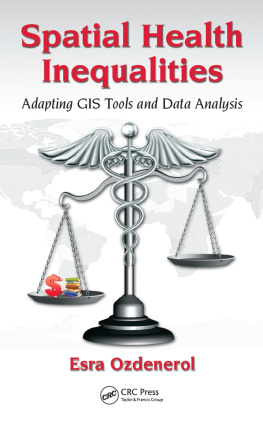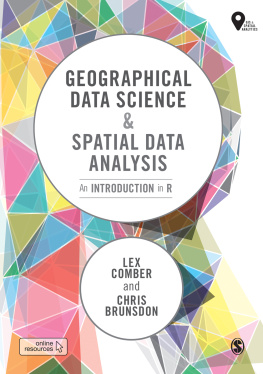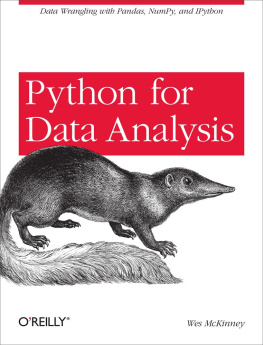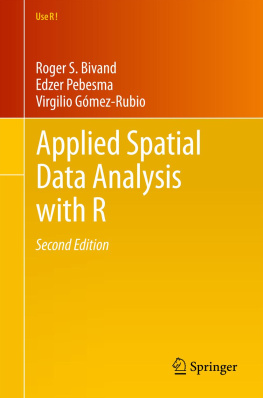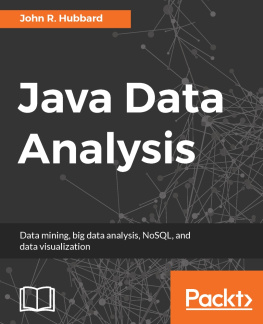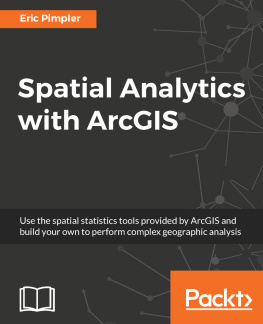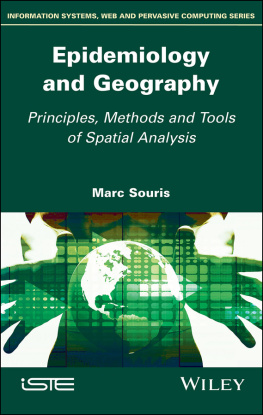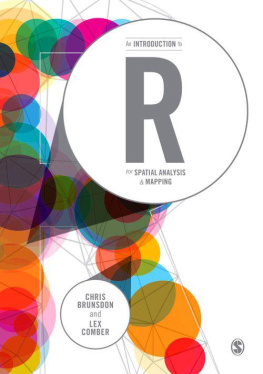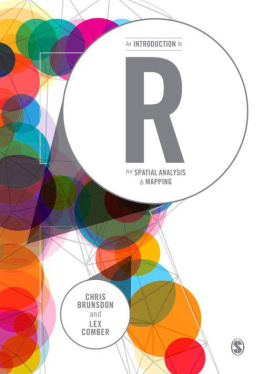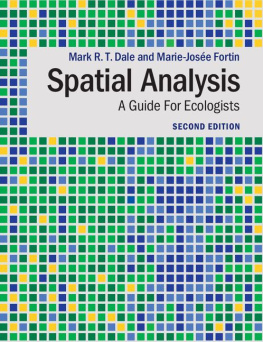Ozdenerol - Spatial Health Inequalities: Adapting GIS Tools and Data Analysis
Here you can read online Ozdenerol - Spatial Health Inequalities: Adapting GIS Tools and Data Analysis full text of the book (entire story) in english for free. Download pdf and epub, get meaning, cover and reviews about this ebook. City: Boca Raton, year: 2016, publisher: CRC Press, genre: Politics. Description of the work, (preface) as well as reviews are available. Best literature library LitArk.com created for fans of good reading and offers a wide selection of genres:
Romance novel
Science fiction
Adventure
Detective
Science
History
Home and family
Prose
Art
Politics
Computer
Non-fiction
Religion
Business
Children
Humor
Choose a favorite category and find really read worthwhile books. Enjoy immersion in the world of imagination, feel the emotions of the characters or learn something new for yourself, make an fascinating discovery.
Spatial Health Inequalities: Adapting GIS Tools and Data Analysis: summary, description and annotation
We offer to read an annotation, description, summary or preface (depends on what the author of the book "Spatial Health Inequalities: Adapting GIS Tools and Data Analysis" wrote himself). If you haven't found the necessary information about the book — write in the comments, we will try to find it.
Ozdenerol: author's other books
Who wrote Spatial Health Inequalities: Adapting GIS Tools and Data Analysis? Find out the surname, the name of the author of the book and a list of all author's works by series.
Spatial Health Inequalities: Adapting GIS Tools and Data Analysis — read online for free the complete book (whole text) full work
Below is the text of the book, divided by pages. System saving the place of the last page read, allows you to conveniently read the book "Spatial Health Inequalities: Adapting GIS Tools and Data Analysis" online for free, without having to search again every time where you left off. Put a bookmark, and you can go to the page where you finished reading at any time.
Font size:
Interval:
Bookmark:

Spatial Health Inequalities
Adapting GIS Tools and Data Analysis
Spatial Health Inequalities
Adapting GIS Tools and Data Analysis
Esra Ozdenerol

CRC Press
Taylor & Francis Group
6000 Broken Sound Parkway NW, Suite 300
Boca Raton, FL 33487-2742
2017 by Esra Ozdenerol
CRC Press is an imprint of Taylor & Francis Group, an Informa business
No claim to original U.S. Government works
Printed on acid-free paper
Version Date: 20160617
International Standard Book Number-13: 978-1-4987-0150-1 (Hardback)
This book contains information obtained from authentic and highly regarded sources. Reasonable efforts have been made to publish reliable data and information, but the author and publisher cannot assume responsibility for the validity of all materials or the consequences of their use. The authors and publishers have attempted to trace the copyright holders of all material reproduced in this publication and apologize to copyright holders if permission to publish in this form has not been obtained. If any copyright material has not been acknowledged please write and let us know so we may rectify in any future reprint.
Except as permitted under U.S. Copyright Law, no part of this book may be reprinted, reproduced, transmitted, or utilized in any form by any electronic, mechanical, or other means, now known or hereafter invented, including photocopying, microfilming, and recording, or in any information storage or retrieval system, without written permission from the publishers.
For permission to photocopy or use material electronically from this work, please access www.copyright.com (http://www.copyright.com/) or contact the Copyright Clearance Center, Inc. (CCC), 222 Rosewood Drive, Danvers, MA 01923, 978-750-8400. CCC is a not-for-profit organization that provides licenses and registration for a variety of users. For organizations that have been granted a photocopy license by the CCC, a separate system of payment has been arranged.
Trademark Notice: Product or corporate names may be trademarks or registered trademarks, and are used only for identification and explanation without intent to infringe.
Visit the Taylor & Francis Web site at
http://www.taylorandfrancis.com
and the CRC Press Web site at
http://www.crcpress.com
This book is dedicated to my two sons, Derin and Deniz; my dad, the Honorable Justice Erdogan Ozdenerol; my mother, Umran Ozdenerol; my sister, Emel Ozbay; my brother-in-law, Alp Ozbay; my two beautiful nieces, Irem and Zeynep Ozbay; and my deceased grandmother, Sidika Erolozden. My family has given me endless support and undivided affection over the years even though there were oceans between us. Thank you for all you have sacrificed during this process.
Contents
It is my great pleasure to write a foreword for this book, written by a talented medical geographer. Since the turn of the century, there have been quite a few books on spatial epidemiology, statistical and geographic information system (GIS) approaches in medical geography, and spatial analysis for health and environment studies. The uniqueness of this book is its focus on spatial health inequalities, which are pervasive in the United States as well as many countries in the world. This book is the first to put together GIS, mapping, and spatial analytical methods to illustrate how these various methods can be used to analyze spatial health inequalities.
Health inequality or disparity has long been a global health problem. Health inequality, as this book states, refers to different health outcomes of individuals due to their differences in socioeconomic status. Low-income, underserved minority groups are more vulnerable to diseases and epidemics and are more likely to lead to adverse health outcomes. In other words, borrowing the concept of resilience in disaster studies, individuals that have higher socioeconomic statuses are generally more resilient to adverse health effects; they generally have better prevention, are more prepared, and bounce back faster than individuals that have lower socioeconomic statuses.
Extending health inequality to spatial health inequality represents a major conceptual as well as practical advance in the study of epidemiology and environmental health. As this book states, health inequality involves both the person and the place. The neighborhoods and the biophysical, political, and cultural environments all play key roles in affecting the health outcomes of individuals. Unequal spatial distribution of resources such as clinics, hospitals, public transportation, fresh food markets, and schools could make the community as a whole more vulnerable and less resilient to adverse health effects, leading to lower community resilience of health. Thus, analysis of health inequalities must also consider its spatial context or larger environment to better understand the problem.
GIS and spatial analytical methods are most apt in studying spatial health inequalities. Moreover, traditional statistical or data mining methods when enhanced with GIS mapping and analysis can help reveal more effectively the spatial patterns of disparity and the factors associated with the patterns. There are many examples in the literature, as well as shown in this book, on how GIS and mapping can demonstrate spatial health inequalities and help in deriving better and more useful hypotheses. For example, my previous studies on mapping Chinas cancer mortalities by county in the early 1970s revealed high concentrations of different types of cancers at different localities. Through an intense data collection and mapping effort on AIDS incidence and mortality in the United States in the 1980s, we were able to confirm a national trend of AIDS spreading to rural America, generating a major discussion of regional disparity that involves the north, the south, the rural, and the urban, in addition to the rich and the poor.
The approach used in this book is clever and useful. This book demonstrates the spatial health inequalities in six most important topics in environmental and public health, including food insecurity, birth health outcomes, infectious diseases, childrens lead poisoning, chronic diseases, and health-care access. These are the topics that the author has done extensive research on. Each chapter addresses a topic. In each chapter, this book will provide a detailed description of the topic from a global perspective, identify relevant data and data sources, discuss key literature on appropriate techniques, and then illustrate with real data with mapping and GIS techniques. It is important to note that while spatial analysis is useful, inappropriate applications of the spatial analytical methods and a lack of understanding of the errors and uncertainties involved in spatial analysis could generate erroneous results and interpretations. This book will discuss the appropriate techniques and bring awareness of the possible errors and uncertainties involved in spatial analysis. Finally, this book has a web-based resource that contains data from the case studies relevant to each health topic. The web page provides links to download data and instructional material to supplement the case studies.
Spatial health inequalities are intertwined with issues in environmental justice and community resilience; they are all closely interrelated. GIS methods are the prime tools to reveal the patterns, identify the factors, assess the progress, and ultimately plan for better health resilience. This book is a timely and valuable addition to the literature. It will be an effective text and resource for those who want to understand the issue of spatial health inequalities and how to analyze the issue with GIS and spatial analysis.
Font size:
Interval:
Bookmark:
Similar books «Spatial Health Inequalities: Adapting GIS Tools and Data Analysis»
Look at similar books to Spatial Health Inequalities: Adapting GIS Tools and Data Analysis. We have selected literature similar in name and meaning in the hope of providing readers with more options to find new, interesting, not yet read works.
Discussion, reviews of the book Spatial Health Inequalities: Adapting GIS Tools and Data Analysis and just readers' own opinions. Leave your comments, write what you think about the work, its meaning or the main characters. Specify what exactly you liked and what you didn't like, and why you think so.

